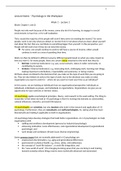1
Lecture Notes – Psychology in the Workplace
Week 1 – Lecture 1
(Book: Chapter 1 and 2)
People not only work because of the money, some also do it for learning, to engage in a social
environment, to have fun, or for self-realization.
Then, would the majority of the people still work if they were not needing the money? For some
people, work is not only what you obtain or receive from it, but about what you learn about yourself
and about the fact that you contribute to something bigger than yourself. In this perspective, yes!
People will still work even if they do not need the money.
For some, one would continue to work to still have a source of income, others would
continue to work as a way of spending their time.
Work can then be defined in different ways by different people based on what you value, based on
how you view it. For many people, there are certain values attached to the work that they do.
Extrinsic (=external motivators): e.g. pay, social contacts, status in wider community, or
contributing to society.
Intrinsic (=internal motivators): e.g. interesting work, challenging work, learning new things,
making important contributions, responsibility and autonomy, or being creative.
All these values are linked to the decisions that you make on the type of work that you are going to
do. They are also linked not only to the type of work, but to the decisions you make on what
organization you want to work for – where do you want to invest your time as an individual?
In this course, we are looking at individuals from an organizational perspective: individuals as
individuals, individuals as groups, and individuals in organizations. Organizations can give you an
opportunity for your extrinsic or intrinsic values.
I-O psychology applies psychological principles, theory, and research to the work setting. The thing to
remember is that when we look at I-O psychology is that it is moving into domains as communities,
cultural influences, networks, and work-life balance.
I-O psychologists are scientists, but also teachers who train in the research and application of I-O
psychology. Furthermore, they are consultants and staff psychologists. So, taking what they learn
theoretically and making it applicable to work in organizations.
I-O psychology helps develop strategies that build better organizations. An I-O psychologist can help
organizations with
staffing and workforce development (personal or industrial psychology);
enhancing motivation, team effectiveness, and organizational development (organizational
psychology); and
work design and workplace climate issues (human engineering).
Some common issues that are normally addressed in I-O psychology are
employment discrimination, e.g. aging and generational differences;
psychosocial or physical health, e.g. stress, safety, and joblessness;
the concept of “work-life balance”, or work-life integration; and
the “new world of work”, this changing involving space that you are living in and training
towards someday where things may be more technically advanced and automated.
, 2
Some special issues in I-O psychology are
sports, e.g. teamwork or coordination;
humanitarian, e.g. micro-credit or U.N. policy;
conflict areas, e.g. police force or anti-terrorism; and
special assessment, e.g. OSS spy recruiting or choosing the best person to deactivate a bomb.
While there are common issues where I-O psychology looks at, there is a variety of settings it can be
used in.
A strong basis of I-O psychology is the practical component of it, so it is strongly based on the
scientist-practitioner model: using scientist tools and research in the practice of I-O psychology –
looking for the science on how to guide is, how to best deal with something in the workplace.
Common areas of concentration for I-O psychologists are selection and placement, training and
development, organizational development, performance measurement, quality of work life, and
engineering psychology. (this is not an exhaustive list)
The bottom line in any organization is performance. If we think of (job)performance it can also
include things as creativity or your motivation. This all are key depend variables in I-O research.
It is furthermore a multilevel science – there are many
different layers in the organizations I-O psychologists work in.
There are also some changes in the workplace, especially more recently (since 1980s): personal
computing, telecommuting and virtual teams, videoconferencing, etc. And after the pandemic, more
things can be added to this list for sure.
I-O psychology applies theories, models, and principles from all areas of psychology. Studying it
improves your understanding of how individuals and groups act, think, and feel in organizations – it
does not matter where you work, it is something that is practical to have knowledge about.
It is important that we think critically and ask questions and think about the content, as the lay
theories and beliefs about I-O psychology may be false, or either may be true in a very narrow set of
circumstances.
Hawthorne studies: people were seen more as machines and once we have them in the workplace
how do we get most out of them. When the Hawthorne studies started, there was looked at light
intensity (making it brighter) to see how this influences worker productivity. The hypothesis was that
light intensity affects worker productivity. But, what they found instead was that the mere fact that
there were researchers in the room, people who were interested in how the workers work as people,
which had an impact on the output.
, 3
There are psychological and social factors that are important in explaining employees’ job
performance Human Relations Movement: it is just as important to look at the individual
who is doing the work than to how the work is being done.
I-O psychology provides a set of tools that allows people to (I) understand, (II) analyze, (III) describe,
and (IV) predict behavior in organizations.
However, do not think of theories in terms of right or wrong! Think of them as either helpful or not
helpful – theories, models, or approaches complement each other. There is thus no one right or only
solution for (I-O) problems.
The contingency approach is something I-O psychologists pay a lot of attention to, basically saying
whether something will have an effect really depends on what is in the situation – the effectiveness
of any person, trait, or strategy often depends on the situation.
I-O psychologists specify situation-type variables (contingency factors, conditions, or
moderators) that permit certain traits and behaviors to be effective within a given
organizational context.
Whether leadership behavior will have effect on employee behavior depends on this contingency,
condition, or moderator, and what this condition is, is something I-O psychologists want to find out.
Fiedler (1968) was the first who explained leader behavior from a contingency perspective. He argues
that the effectiveness of leader style depends on the kind of situation the leader is dealing with –
Fiedler’s contingency theory of leadership. He identified two distinct leader styles: relationship-
oriented vs. task-oriented. And whether you take relationship- or task-oriented will be determined
on three situational characteristics (contingency factors):
leader-member relations: good vs. poor;
task structure: structured vs. unstructured; and
position power: strong vs. weak.
There is no one-for-all answer, it depends on the situation. All of the information of the situational
characteristics should be taken into account whether one leadership style is more effective than the
other.
, 4
Week 1 – Lecture 2
(Book: Chapter 3)
Fiedler’s contingency theory of leadership is based on the belief that:
A. There is a single style of leadership appropriate to all mangers.
B. There is a single style of leadership appropriate to all situations.
C. There is no single style of leadership appropriate to all situations.
People differ. What do individual differences tell us?
Personality: captures what people are like as individuals.
Ability: captures what people can do as individuals.
Personality are the structures and propensities inside a person that explain his/her characteristic
patterns of thoughts, emotions, and behavior. It is basically a collection of different traits.
Traits are recurring regularities or trends in people’s responses to their environment. While we could
come up with thousands of traits adjectives, most of them would cluster around five general
dimensions the Big Five.
Conscientiousness: responsible, persistent, planful, achievement oriented.
Extraversion: sociable, assertive, talkative, energetic.
Agreeableness: cooperative, trusting, likeable, friendly.
Emotional stability: secure, calm, poised, relaxed.
Openness to experience: curious, imaginative, independent, creative.
Conscientiousness and emotional stability are positively correlated with job performances in
virtually all jobs!
Openness to experience, conscientiousness, and agreeableness predicted discretionary pro-
social and pro-organizational behaviors across jobs!
Ability is the relatively stable capabilities people have to perform a particular range of different but
related activities. This is in contrast to skills, which are more trainable and improvable. As with
personality, about half of the variation in ability levels is due to genetics.
There are several types of human abilities.
Cognitive: related to the acquisition and application of knowledge in problem solving.
o E.g. verbal, quantitative, reasoning, spatial, perceptual.
Emotional intelligence: related to the management and the use of emotions when
interacting with others.
Physical: related to the performance of physical work.
o E.g. strength, stamina, flexibility, coordination, psychomotor, sensory.
How important is ability?
Cognitive ability predicts job performance in virtually all jobs.
Emotional intelligence predicts performance only when jobs involve a high degree of
emotional labor (e.g. flight attendant, emergency-room nurse, or salesperson).
Physical abilities predicts performance only when jobs require a high level of capabilities (e.g.
professional athletes).
Individual Differences model: adults have a variety of attributes that are relatively stable over a
period of time, and people differ with respect to those attributes. These differences remain even
after training (in contrast to skills which can be trained).





